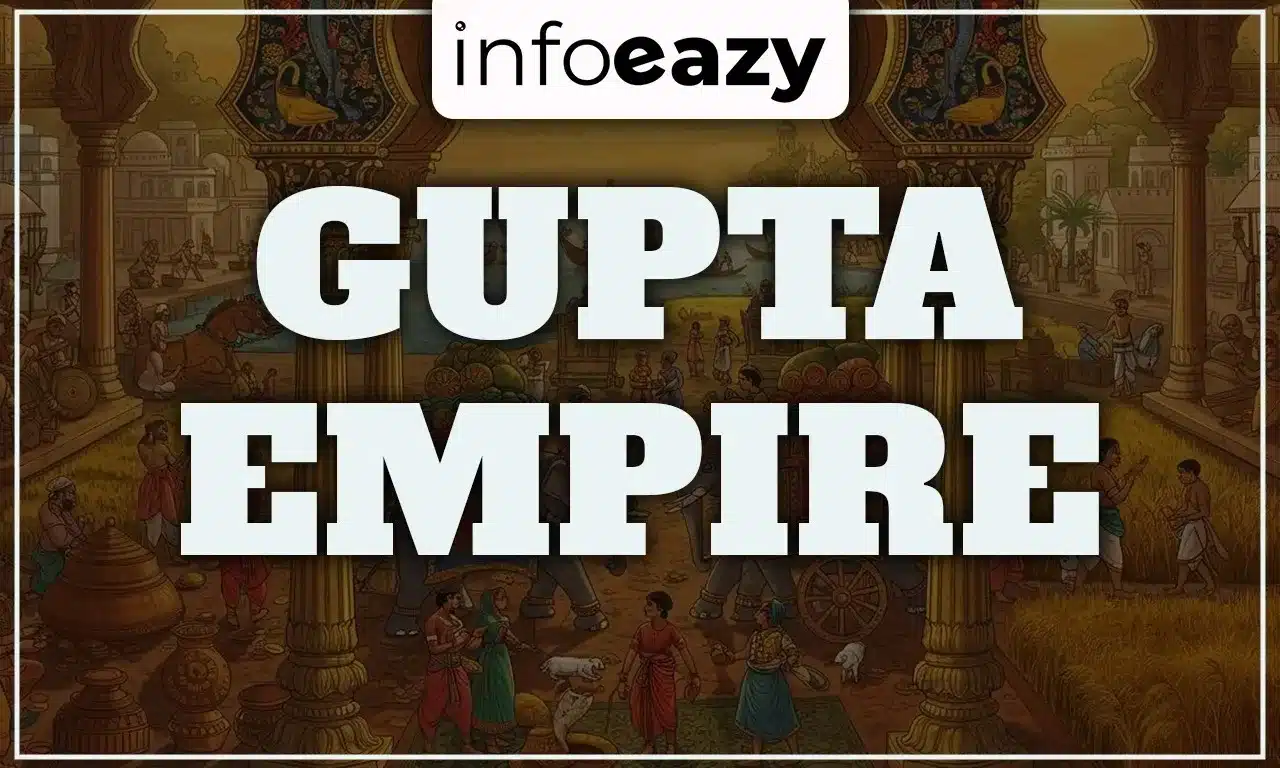The Gupta Empire is one of the most important topics in Indian history for competitive exams. It existed between 320 CE and 550 CE and is remembered for its political stability, cultural progress, and scientific achievements. The period of the Gupta Empire is often called the “Golden Age of India” because of the remarkable developments in literature, art, architecture, mathematics, and astronomy. For aspirants of RRB Group D 2025 and other government exams, understanding the Gupta Empire is essential.
Gupta Empire
The Gupta dynasty was founded by Sri Gupta around the 3rd century CE in the Magadha region. The empire reached its peak under rulers like Chandragupta I, Samudragupta, and Chandragupta II Vikramaditya. Pataliputra (modern Patna) was the capital of the empire. The Guptas controlled large parts of northern and central India, including Magadha, Bengal, Uttar Pradesh, and even parts of Rajasthan and Gujarat. This empire was also marked by foreign trade, flourishing cities, and the beginning of major universities like Nalanda.
Gupta Empire: Overview
The comprehensive overview of the Gupta Empire has been tabulated below for the quick reference of the students preparing for Competitive Exams:
| Gupta Empire: Overview | |
| Aspect | Description |
| Period | 320 CE – 550 CE (approx.) |
| Founder | Sri Gupta |
| Greatest Rulers | Chandragupta I, Samudragupta, Chandragupta II (Vikramaditya) |
| Last Ruler | Vishnugupta |
| Capital | Pataliputra (modern Patna) |
| Empire Spread | Northern and central India (Magadha, Bengal, Uttar Pradesh, Rajasthan) |
| Other Name | Golden Age of India |
| Sources of History | Coins, inscriptions (Allahabad Pillar, Junagadh Rock), Chinese accounts |
| Achievements | Political stability, economic prosperity, cultural and scientific growth |
Rulers of the Gupta Empire
The major rulers and their contribution has been tabulated here:
| Rulers of the Gupta Empire | ||
| Ruler | Period | Contribution |
| Sri Gupta | c. 240-280 CE | Founder of dynasty, ruled Magadha region |
| Ghatotkacha | c. 280-319 CE | Consolidated kingdom, limited expansion |
| Chandragupta I | 320-335 CE | Expanded empire, married Kumaradevi, coins with title Maharajadhiraja |
| Samudragupta | 335-375 CE | Military conquests, called “Napoleon of India”, Allahabad Pillar inscription |
| Chandragupta II (Vikramaditya) | 375-415 CE | Golden Age ruler, defeated Western Satraps, patron of arts and science |
| Kumaragupta I | 415-455 CE | Founded Nalanda University, maintained stability |
| Skandagupta | 455-467 CE | Defended India against Hun invasions, empire weakened after his rule |
| Later Guptas | 467-550 CE | Decline of empire, lost power to Harsha and regional kingdoms |
Administration, Economy and Society of Gupta Age
The Political System, Financial Status and Culture of the Gupta Age has been tabulated below:
| Administration, Economy and Society of Gupta Age | |
| Aspect | Description |
| Political System | Monarchy, decentralized provincial administration (Bhuktis) |
| Provincial Heads | Uparikas (governors of provinces) |
| Revenue System | Land tax, customs duties, tributes, trade tax |
| Economy | Agriculture-based, active trade with foreign regions (Roman coins found) |
| Currency | Gold coins (dinaras), silver, copper coins |
| Society | Varna system, caste hierarchy rigid, but merchant class prospered |
| Urban Centers | Pataliputra, Ujjain, Prayag, Mathura, Nalanda |
| Trade Routes | Silk Road connections, maritime trade via Gujarat ports |
Art, Architecture, Science, and Religion of Gupta Age
The Creativity and Innovations at the time of Gupta Age was rising at a peak. The key aspects of the Art, Literature, Architecture, Science and Religion has been tabulated below:
| Art, Architecture, Science, and Religion of Gupta Age | |
| Category | Features |
| Art and Architecture | Temples (Deogarh, Dashavatara), cave temples, stupas, sculptures |
| Science & Maths | Aryabhata introduced zero, decimal system, heliocentric theory |
| Astronomy | Calculations of eclipses, solar year length |
| Literature | Kalidasa’s plays (Abhigyan Shakuntalam, Meghaduta), Harshacharita |
| Religion | Hinduism dominant, but Buddhism and Jainism flourished |
| Coins & Inscriptions | Gold coins, Allahabad Pillar inscription of Samudragupta |
| Cultural Achievements | Growth of Sanskrit, music, theatre, paintings |
Decline of the Gupta Empire
The decline of the Gupta Empire started after the reign of Skandagupta. Continuous invasions by the Hunas weakened the empire, along with internal conflicts and weak rulers. The loss of wealth from wars, reduced trade, and rising power of regional kingdoms further damaged Gupta control. By around 550 CE, the empire had collapsed, and northern India came under the influence of Harsha and other small dynasties.
Gupta Empire Questions for RRB Group D 2025
- Who was the last ruler of the Gupta dynasty? Vishnugupta
- Which Gupta ruler was also known as Vikramaditya? Chandragupta II
- Which Chinese traveler visited the Gupta Empire? Fa Hien
- Which Gupta ruler founded Nalanda University? Kumaragupta I
- Which port cities were important during the Gupta period? Ports in Gujarat such as Bharuch
- Which Gupta king issued coins with the title Maharajadhiraja? Chandragupta I
- Which Gupta ruler defended India against Hunas? Skandagupta
- What was the main source of revenue in Gupta administration? Land tax
- Which inscription records the achievements of Samudragupta? Allahabad Pillar inscription
- Which language flourished the most during Gupta period? Sanskrit
- Founder of Gupta Empire? Sri Gupta
- Which ruler is called Napoleon of India? Samudragupta
- Golden Age ruler? Chandragupta II (Vikramaditya)
- Which university was founded in Gupta period? Nalanda University
- Religion during Gupta period? Hinduism, Buddhism, Jainism
- Widely used coins in Gupta period? Gold dinaras, silver, copper
- Capital of Gupta Empire? Pataliputra
- Which inscriptions describe Samudragupta’s conquests? Allahabad Pillar inscription
- Famous Sanskrit poet of Gupta period? Kalidasa
- Which Gupta ruler defended against Huns? Skandagupta
Gupta Empire FAQs
Q1. Who was the founder of Gupta Empire? +
Q2. Why is the Gupta period called the Golden Age of India? +
Q3. Who was the most powerful ruler of Gupta Empire? +
Q4. What was the capital of Gupta Empire? +
Q5. Which famous mathematician lived during Gupta period? +
Tags: Gupta Empire




